How the pulser pump works,
benefits to the environment,
and details about how much
you can pump
This is detailed stuff!! Please take your time.
1 Hydropower
Explanation and picture
2 Working Principle
Hidden Bonus!! Environmental benefit
explained.
4 Estimate site potential
Your site What is it worth? Potential savings per anum
5 How much can you pump?
Working model and figures.
6 Set-up choices
You can make a pulser pump in many ways. Here are some.
Remind me to update the diagrams!
Email
Home
page
Pulser
pump index
Try the tables to navigate up and down this page
HYDROPOWER
Hydropower is the name of power derived from the energy of falling water.
Water falling 2 meters or more can be used to generate electricity.
Under 2 m, costs increase, returns and efficiency diminish
and in consequence, these sites are usually unused. There are a few ways
of using these sites, hydram pumps, waterwheels, etc. For various reasons,
these are rarely used.
The PULSER PUMP is another way of using
this power. Perhaps it suits your site and your intended use. If you are
in doubt, look up air lift pumps. Airlift pumps are old technology but
still in use today. Mostly for pumping water from very deep underground.
Water supply utilities, and industries which use lots of water commonly
use them. Similar physics governs the blowing of feed into farmers storage
bins from trucks.
The pulser pump works in broadly the same way. There is enormous
benefit to be had from such a Simple
system. Dig the hole, put in the pipes, divert part of the stream
through it and pump! It works automatically.
I will describe only the pumping of water and the pumping of
air for aeration in detail. However there are many possible uses. I will
provide you with only a general idea of what to do in those cases.
INTRODUCTION
Pulser pumps use the power of falling water directly to pump water
or air.
The pulser pump is cheap to make and to install, it has no moving parts
, it is reliable, needs little maintenance and it improves
the water quality in the river or stream in which it operates.
They can be used in flatter areas, with heads of half meter or
more and flows as low as 250 liters per minute (lpm). We recommend 500
lpm minimum. 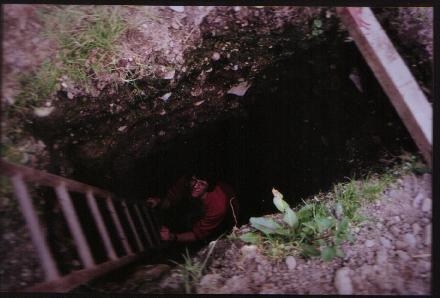
Warning
Use a contractor and machines. I was stupidly risking my life.
My brother Edward died (aged just 20) on Sunday
21st May 2000 in a far less risky situation. Please don't take any risks
with your life.
see working model figures
How it works
Stage one
Water falling in a waterfall carries air bubbles below the surface
in the next pool and they quickly return to the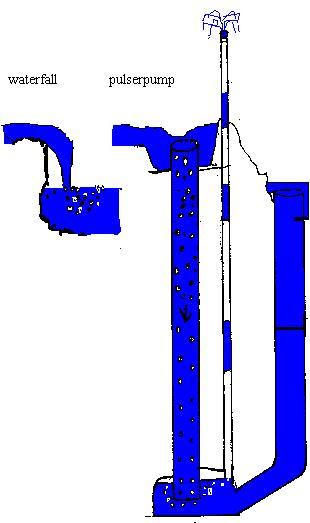 e
e
surface. In the pulser pump, the ''waterfall'' occurs in a vertical
pipe and the water flowing into the pipe blocks the return and forces the
bubbles deeper into the pipe. The bubbles continue down until they enter
a chamber where they separate from the water. The water returns to
the surface via an exit pipe and the air (under pressure due to the
depth) collects in the chamber. Energy from the falling water is now stored
in that air.
Stage two
The air from the chamber returns to the surface via a small diameter pipe.
The pipe contained water some of which falls back through the air as it
rises but much of it is carried to the top and forced
out of the pipe by the rising pressurized air. As water and air leave
the pipe at the top, they are replaced at the bottom and a dynamic equilibrium
is set up. It is hard to believe that 2.5 meters of air pressure can be
used to pump water 3 meters, 4 meters or even 8 meters higher! Fall
back makes it all possible.
Imagine the air pushing a column of water 2 meters long all the way
up the pipe. No problem there because the air column pressure is equal
to a column of water 2.5 meters high. Once it reaches the top and
is expelled, water rushes in to the bottom to replace it and the cycle
repeats itself. 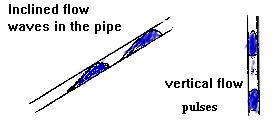
Stage two (inclined pipes)
The pipe taking the air away does not need to go straight up. If it rises
at an incline, it works too. This can mean a shorter simpler
all underground system. In this case, the air blowing in the pipes
makes waves in the water in the pipes. If the wave is high enough, it blocks
the pipe and travels rapidly through it. It isn't as efficient as going
vertically, it needs larger bore pipes but if it delivers enough water
for your needs, then why not?
HIDDEN BONUS!!!!!!
This type of pump acts as a water treatment
plant in the river itself! This is a very useful aspect. Can
anybody quantify its worth to the environment?
HERE is how it works:
As the stream water passes down the pipe mixed with the tiny air bubbles,
gas exchange takes place under ideal conditions. The bubbles are
tiny, the water is turbulent and the pressure is increased. Not only is
the water well oxygenated under these conditions, also volatile nitrogen
and sulfur compounds transfer to the air bubbles. Therefore the river becomes
oxygenated and cleaner and fresher! A better life for fish
and other freshwater animals. The calm well oxygenated water at the
exit will be a refuge for water creatures during pollution events which
typically reduce the oxygen levels.
HOW MUCH WATER CAN YOU PUMP?
I will give you the figures for pumping up a vertical pipe.
The figure for pumping up an incline will be less and it depends on a lot
of factors. Assume it to be half of the vertical pipe figure.
You must first measure the height that you wish to pump. This can best
be done with a spirit level , a measure, a line level and some poles or
with a line level and some poles. You put the line level or the water
level between the poles between the pump and the use site and add
up the vertical drop on each pole between them. This total is your vertical
height (measure it in meters).
You can pump :
Liters per minute
Head X lpm at dam ÷ vertical height X 0.1
liters per hour
Head X lpm at dam ÷ vertical height X 6
liters per day
Head X lpm at dam ÷ vertical height X 144
I have done the figures in this way because
although the pump works all day, if you want to use the water rapidly at
certain times, then you must have enough storage capacity.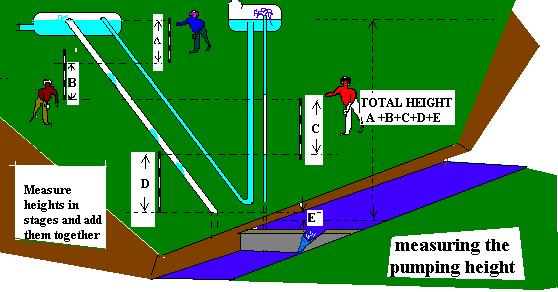
WORKING MODEL Approx.
Flow 260 liters per minute of water , head 0.5 m, going 2.5m deep and pulsing
to 3.6 m gave 4 liters per minute. The same setup gave 1.5 lpm at 5 meters
high. This was with a split process pump using 10 cm (4 inch) pipes for
the stream water and using 19 mm (3/4 in) for the pulsed water delivery.
The efficiency decreases like this as one pumps higher. On the other hand,
2 stages to 7 meters will give about 2 liters per minute with the
same setup. Going deeper also increases the efficiency. Perhaps you have
an abandoned well that you can use? Less pipes are used in that situation
and the well will not be filled in. The working model in the example
has just entered its second decade! It is in the hole in the Scary
picture. Apart from cleaning the sieve occasionally, there
has been no maintenance. If you can dig deeper, you should get a similar
efficiency at a similar height/dept ratio.
Once again, I recommend a larger flow than this, and the use
of 15 cm plastic pipes or bigger.
ESTIMATE THE SITE POTENTIAL
Choose the site carefully with enough head and flow and near to the
user, within 100 meters.
Examine a few alternative sites. Also you must recognize that
the site potential can only be estimated . Do not waste time worrying
about being super accurate. Stream and river flow varies enormously during
the year and from year to year. I suggest that you measure the stream flow
in a place where it is fairly rectangular, straight and fairly calm flowing.
Then you can make allowance for the height of the river. Is it higher
or lower than normal as you measure it ? A good guide is that if
a river is twice as high, about 3 times as much water is flowing.
You may then be able to use past experience to correlate your measurement
with the average flow in the stream.
MEASURING THE
FLOW
1 Chose a fairly straight part of the stream where
the cross section is approximately rectangular.
2 Place 2 poles in the stream 2, 3, or 4 meters
apart.
3 Time a piece of wood floating down the middle between
two poles. Repeat twice and divide the total
seconds by three. (Seconds)
4 Formula depth
(cm) X width (cm) X distance between the
poles (meters) X 4.5 ÷ seconds
This will give you the flow in liters per minute
MEASURE THE HEAD
Head refers to the distance that the water will fall from the
surface of the water in front of the dam to the surface of the water behind
the dam . You should measure this distance with a spirit level
or a water level. You can simply siphon water through a garden hose
over the dam. Once the water flows through the hose, simply
raise the end until the water no longer flows. Then measure the distance
from here to the surface of the water under the dam. The distance should
be 50 cm or more.
If you are making the dam from scratch, then you should get
advice from fisheries people, (and someone with engineering experience
if it is more than 0.5 m high).
Remember, these things should pay for themselves with
their work done. Home
Page
YOUR SITE ................ WHAT IS IT WORTH?
We will assume that you use the pulser pump throughout the year.. (My
figures, below, are calculated from figures in an edition of
Scientific America which was all about energy efficiency).
What is it worth? I will give the value per year in kWh
of electricity replaced, in coal saved and in savings in production of
carbon dioxide. If you wish to include the environmental benefit of oxygenating
the river, it is roughly equal to the figures for air pumping. Of
course, you get no economic benefit from this. It is, if you like,
your gift to the environment. In London, the Thames river is
oxygenated with big electric air pumps to produce this same effect.
YOUR SITE POTENTIAL SAVINGS PER ANUM
Pumping water
kW of electricity saved per year Head X
liters per minute ÷ 2.28
kilograms of coal saved per year Head X
liters per minute ÷ 3.72
CO2 reduced by kg per year
Head X liters per minute ÷ 1.79
Pumping air
kW of electricity saved per year Head
X liters per minute ÷ 0.76
Kilograms of coal saved per year Head X liters
per minute ÷ 1.24
CO2 reduced by kg per year
Head X liters per minute ÷ 0.55
Different models for different situations
With any technology, you will be faced with different
models to deal with different situations, I strongly recommend No.
3 (split process) because of its versatility and efficiency.
Below is an overview of several ways of setting up the system. (Not
to scale). Use it to estimate material
costs. It should give you a rough idea of how
much pipe you will need to set up the system in one of the different ways.
I recommend No.3 (for lots of reasons!), No.2 is the simplest, but the
pipes to the user are generally bigger (more expensive), No.1 may
need guy wires to hold up the pipes, cost that in, and if the head is more
than 1.5 meters, No 4, a hydram or a low head hydroelectricity setup
may be an option for you. Be sure that they will be much
more expensive to build, but that they
definite options at 1.5m or more.
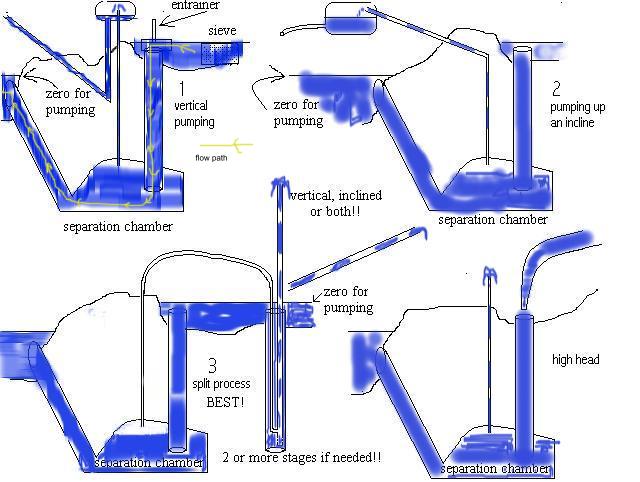
THIS decision diagram should help you make the compromises necessary
to
make a suitable system at the right price for your particular situation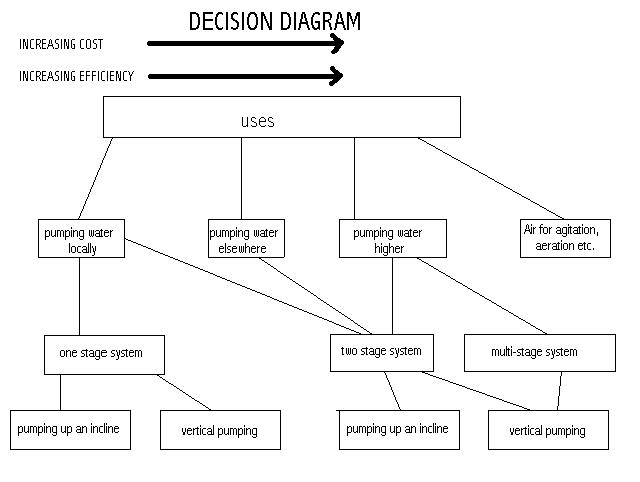
Email
Page contents
Home
page
Pulser
pump index